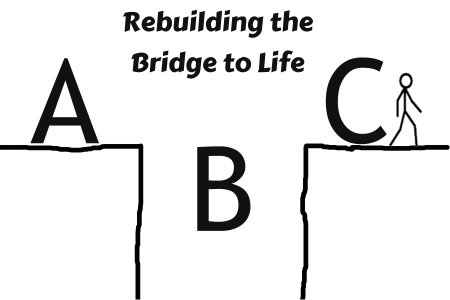Rebuilding the Bridge to Life
It is good to rethink the gospel presentations we use.
16 MARCH 2017 · 13:05 CET

Most of us have seen or used the bridge to life illustration at some point. Maybe you have even preached your way through it. On one side there is God and on the other there is humankind, and they are separated by a chasm (sin). Perhaps God is represented by a throne or a crown. Try as we might we cannot leap across the chasm or build a bridge of good works, so God has to do the bridge-building. The cross is interposed and we can walk across to God. Many people have come to faith with this illustration, so please don’t see this post as a criticism of it.
It is good to think through what is being communicated and I do think there are some concerning features of the gospel offered here. For instance, let’s ponder the assumed motivation. Are people really trying to leap the chasm to get to God? Are people longing for closeness with the throne/crown authority figure presented in this illustration? I don’t remember talking to someone who was desperate to get to God and disappointed that they could not. Furthermore, the relationship offered seems ambiguous – what sort of connection will we have with this throne/crown if we do choose to walk his way?
I’d like to offer another version. Why? Because it is good to rethink the gospel presentations we use. Even if we end up rejecting my modification, the exercise will surely be helpful in thinking through how we present the gospel.
Instead of having the human figure facing towards God and apparently motivated to move towards God throughout the illustration, let’s draw him or her facing away from God. We were created for relationship with God but we have turned away. Introduce the chasm (sin is our rebellion against both God and the love he has for us). Now the illustration is ready to fill in.
A. On the God side, why don’t we represent God in a more Trinitarian way? After all, the authority imagery is obviously incomplete, so let’s play with an alternative. How about a house? Verbally explain the context of the relationship of the Father and the Son by the Spirit – three persons united in love. This relationship was the home, the family, the belonging that we were made for. If it is explained well then the authority of God as creator and ruler can still be established fairly easily. However this is not a God of conflicting realities. He is not “loving, but also just.” Because of the perfect love within the Trinity, therefore God is just, etc.
B. In the chasm let’s draw a manger. Why a manger? Because God’s goal for us is not merely to change our location from the realm of sin to the realm of heaven. God’s goal is union with us, which is why God the Son became one of us – the incarnation matters to the gospel! He had to become one of us so that he could be one with us in marriage, which leads us to …
C. Behind the turned away person let’s draw the cross. Why here? Because ultimately that is how far Jesus travelled for us. It was the price that had to be paid, it was the revelation of what God is like that had to be made, and it was the proposal to win our hearts to entrust ourselves to God. God’s proposal was not in nervousness on one-knee, but in agony with outstretched arms.
Why do I like this adaptation of the classic illustration?
1. Because it speaks of the three great unions of Christianity – the union of God with God (Trinity), the union of God and man in Christ (incarnation), and the union of Christ with humanity (union with Christ).
2. Because God is presented more relationally.
3. Because mankind is not presented as motivated to seek and reach God.
4. Because God, in Christ, came all the way to us. (You could also explain that the Spirit points our hearts to the cross and invites us to be united to Christ.)
5. Because it presents a loving God doing everything for a rebellious and dead-to-God creature like me.
6. Because the gospel is about trusting in that love, rather than about making a personal commitment to travel to God.
7. Because in the gospel we are brought back home by a loving spouse – it is not our solo trek on a God-made bridge to a nice place, in a very real sense he carries his bride over the threshold!
My goal is not to convince you of this illustration. Perhaps you have another classic gospel explanation you have used – why not think through its weaknesses and modify it to better offer the richness of the good news? (For example, the judge doesn’t simply pay our fine, he also approaches the stand and proposes…)
Peter Mead is mentor at Cor Deo and author of several books. This article first appeared at his blog Biblical Preaching.
Published in: Evangelical Focus - Biblical Preaching - Rebuilding the Bridge to Life
